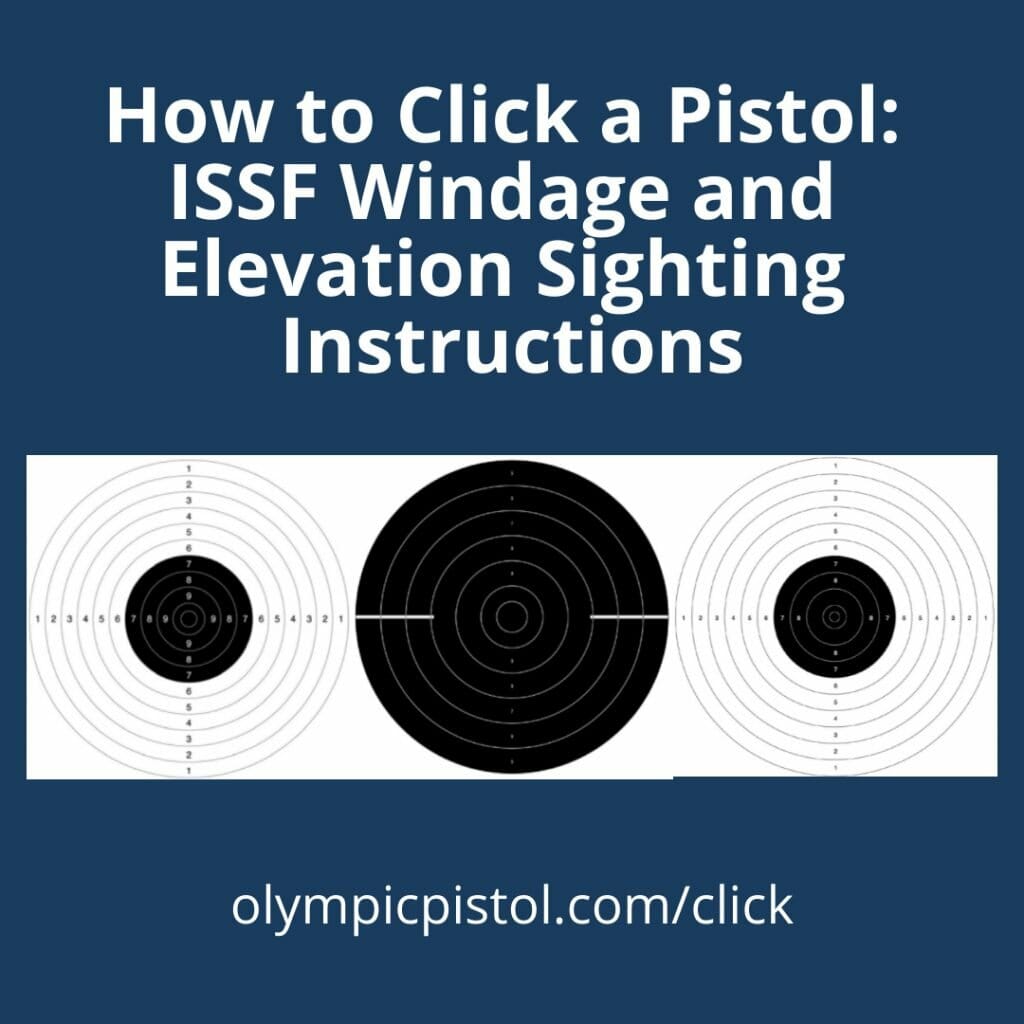Beyond knowing how far each click goes for your pistol and in which direction we need to know how big is each ring for each target we use. The full official instructions are in the ISSF Technical Rules (pages 234-236), but I find them hard to remember and to work with, so I’ve made this table that I hope will be helpful for other pistol shooters and not just me 🙂
The distances below are for the radius (from the center towards the outside) and from one ring to the next, and not for the diameter of the target (from side to side) as they are in the rules. When we are clicking to correct elevation (up-down) and windage (left-right) we just count from one ring to the next so we don’t need to know the diameter.

Table of Contents
Why click and correct elevation and windage
Don’t be afraid to click. Changes in lighting, contrast, and your own body mean that you will be clicking not only when you change ranges, but also as a match or training session progress. There’s no such thing as a “zero” or perfect sight alignment for pistol shooting. The point of impact with the exact same pistol and settings will change from shooter to shooter, as we all size differently and the relationship of our eyes, body, and sights change from person to person.
We use super precise match pistols that allow us a lot of customization to improve the accuracy of our shots: take advantage of it. Click the rear sight knobs to change the point of impact, never change your aiming zone (unless you are shooting a pistol that has fixed sights and you cannot change anything).
How much to click? In which direction?
Learn how much each click of your pistol knobs change the impact on the target and in which direction. This changes from pistol to pistol and sometimes the measure is different for elevation and for windage. The best you can do is carry a note with you (it can be in the case of your pistol) that reminds you how and how much to do it, specially when starting with a pistol (it is easy to mess up with the nerves of a competition). The distances and in which direction you have to turn the knobs are included in the manuals of the pistols, but they usually don’t make calculations easy (except my dear Feinwerkbau P8X). In this link you can find the sighting corrections for air pistols and their manuals (I may get to do 25 m and 50 m some day, or maybe you do it and share it). Some shooters keep and share sighting cheat sheets, keep an eye for them.
To decide how much distance and in which direction you want to move the average of your shot group you discard the fliers. Then figure out more or less (no need for math!) where the average center of the group of shots is and calculate how many rings you have to move in each direction. Use the table below to figure out how much.
The more you do it the easier it gets. As you become more used to do it and improve the announcement of your shots it will become second nature.
Changing from precision to rapid fire pistol targets
6 o’clock vs center hold
Forgetting for a moment the movement in everyone’s aiming area, a 6 o’clock hold is used when you aim lower than the bullseye (I do it about the 4 ring). In the case of a center hold you aim so that the top of your front sight is on the center or right under it (like when you align it with the white lines of a rapid fire pistol target).
ISSF pistol shooters aim at 6 o’clock on precision targets and in the center on 25 m rapid fire pistol targets (most keep a 6 o’clock aim for rapid fire air pistol too).
When changing from one hold to the other, you have to change your sights accordingly (keep a note with the clicks!).
Changing holds
When changing from one target to the other remember that it is always the oposite of the direction the pistol goes:
- You go UP from precision to rapid fire so you have to bring your shots DOWN.
- You go DOWN from rapid fire to precision so you have to bring your shots UP.
I know of more than one shooter (including myself) that has messed this up in a competition.
Pistol target distance chart for clicking
Buy onThese are consecutive distances: from the center of the target to the inner ten line, then to the outer ten line, and then to each subsequent line.
| 10 m Air Pistol Target | 25 m & 50 m Precision Pistol Target | 25 m Rapid Fire Pistol Target | |
| Center to inner 10 (X) | 2.5 mm (0.25 cm) | 12.5 mm (1.25 cm) | 25 mm (2.5 cm) |
| X to outer 10 | 3.25 mm (0.325 cm) | 25 mm (2.5 cm) | 25 mm (2.5 cm) |
| Each subsequent ring | 8 mm (0.8 cm) | 25 mm (2.5 cm) | 40 mm (4 cm) mm (8 cm) |
Download this printable target sighting table for your range.
Targets
The three ISSF pistol targets for your reference:



Bulleseye’s sizes and height to place each target.
I hope this cheat sheet is useful to you. Print it and post it in your range’s wall so that other shooters can benefit from it.
PS: would it make sense to make this table in imperial?
Download the printable target sighting chart for your range and bag.
